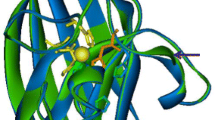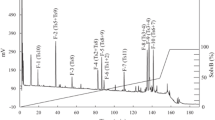Abstract
A novel Cu/ZnSOD from Amaranthus hypochondriacus was cloned, expressed, and characterized. Nucleotide sequence analysis showed an open reading frame (ORF) of 456 bp, which was predicted to encode a 15.6-kDa molecular weight protein with a pI of 5.4. Structural analysis showed highly conserved amino acid residues involved in Cu/Zn binding. Recombinant amaranth superoxide dismutase (rAhSOD) displayed more than 50 % of catalytic activity after incubation at 100 °C for 30 min. In silico analysis of Amaranthus hypochondriacus SOD (AhSOD) amino acid sequence for globularity and disorder suggested that this protein is mainly disordered; this was confirmed by circular dichroism, which showed the lack of secondary structure. Intrinsic fluorescence studies showed that rAhSOD undergoes conformational changes in two steps by the presence of Cu/Zn, which indicates the presence of two binding sites displaying different affinities for metals ions. Our results show that AhSOD could be classified as an intrinsically disordered protein (IDP) that is folded when metals are bound and with high thermal stability.







Similar content being viewed by others
Abbreviations
- AhSOD:
-
Amaranthus hypochondriacus SOD
- CD:
-
Circular dichroism
- IDP:
-
Intrinsically disordered protein
- SOD:
-
Superoxide dismutase
- ROS:
-
Reactive oxygen species
- ICP-OES:
-
Inductively coupled plasma-optical emission spectrometry
References
Fridovich, I. (1995). Superoxide radical and superoxide dismutases. Annual Review of Biochemistry, 64, 97–112.
Droillard, M. J., & Paulin, A. (1990). Isozymes of superoxide dismutase in mitochondria and peroxisomes isolated from petals of carnation (Dianthus caryophyllus) during senescence. Plant Physiology, 94, 1187–1192.
Kanematsu, S., & Asada, K. (1990). Characteristic amino acid sequences of chloroplast and cytosol isozymes of CuZn-superoxide dismutase in spinach, rice and horsetail. Plant & Cell Physiology, 31, 99–112.
Corpas, F. J., Sandalio, L. M., del Rio, L., & Trelease, R. N. (1998). Copper-zinc superoxide dismutase is a constituent enzyme of the matrix of peroxisomes in the cotyledons of oilseed plants. New Phytologist, 138, 307–314.
Alscher, R. G., Erturk, N., & Heath, L. S. (2002). Role of superoxide dismutases (SODs) in controlling oxidative stress in plants. Journal of Experimental Botany, 372, 1331–1341.
Miller, A. F. (2012). Superoxide dismutases: ancient enzymes and new insights. FEBS Letters, 586, 585–595.
Rao, M. B., Tanksale, A. M., Ghatge, M. S., & Deshpande, V. V. (1998). Molecular and biotechnological aspects of microbial proteases. Microbiology and Molecular Biology Reviews, 62, 597–635.
Huerta-Ocampo, J. A., León-Galván, M. F., Ortega-Cruz, L. B., Barrera-Pacheco, A., De León-Rodríguez, A., Mendoza-Hernández, G., & Barba de la Rosa, A. P. (2011). Water stress induces up-regulation of DOF1 and MIF1 transcription factors and down-regulation of proteins involved in secondary metabolism in amaranth roots (Amaranthus hypochondriacus L.). Plant Biology, 13, 472–482.
Kauffman, C. S., & Weber, L. E. (1990). Grain amaranth. In J. Janick, & J. E. Simon (Eds.), Advances in new crops (pp. 127–139). Portland, OR: Timber Press.
Omami, E. N., Hammes, P. S., & Robbertse, P. J. (2006). Differences in salinity tolerance for growth and water-use efficiency in some amaranth (Amaranthus spp.) genotypes. New Zealand Journal of Crop and Horticultural Science, 34, 11–22.
Sharma, S., Bahuguna, S., Kaur, N., & Chaudhary, N. (2014). Biochemical aspects of superoxide dismutase isolated from Amaranthus spinosus: a therapeutically important plant. International Journal of Genetic Engineering and Biotechnology, 5, 35–42.
Bouftira, I., Abdelly, C., & Sfar, S. (2008). Characterization of cosmetic cream with Mesembryanthemum crystallinum plant extract: influence of formulation composition on physical stability and anti-oxidant activity. International Journal of Cosmetic Science, 30, 443–452.
Johnson, F., & Giulivi, C. (2005). Superoxide dismutases and their impact upon human health. Molecular Aspects of Medicine, 26, 340–352.
Angelova, M., Dolashka-Angelova, P., Ivanova, E., Serkedjieva, J., Slokoska, L., Pashova, S., Toshkova, R., Vassilev, S., Simeonov, I., Hartmann, H. J., Stoeva, S., Weser, U., & Voelter, W. (2001). A novel glycosylated Cu/Zn-containing superoxide dismutase: production and potential therapeutic effect. Microbiology, 147, 1641–1650.
Hileman, E. A., Achanta, G., & Huang, P. (2001). Superoxide dismutase: an emerging target for cancer therapeutics. Expert Opinion on Therapeutic Targets, 5, 697–710.
Galaleldeen, A., Strange, R., Whitson, L. J., Antonuk, S., Narayana, N., Taylor, A. B., Schuermann, J. P., Holloway, S. P., Hasnain, S. S., & Hart, P. J. (2009). Structure and biophysical properties of metal-free pathogenic SOD1 mutants A4V and G93A. Archives of Biochemistry and Biophysics, 492, 40–47.
Roberts, B. R., Tainer, J. A., Getzoff, E. D., Malencik, D. A., Anderson, S. R., Bomben, V. C., Meyers, K. R., Karplus, P. A., & Beckman, J. S. (2007). Structural characterization of zinc-deficient human superoxide dismutase and implications for ALS. Journal of Molecular Biology, 373, 877–890.
Muid, K. A., Karakaya, H. C., & Koc, A. (2014). Absence of superoxide dismutase activity causes nuclear DNA fragmentation during the aging process. Biochemical and Biophysical Research Communications, 442, 260–263.
Lods, L. M., Dres, C., Johnson, C., Scholz, D. B., & Brooks, G. J. (2000). International Journal of Cosmetic Science, 22, 85–94.
Saito, N., & Nei, M. (1987). The neighbor-joining method: a new method for reconstruction phylogenetic trees. Molecular Biology and Evolution, 4, 406–425.
Tamura, K., Stecher, G., Peterson, D., Filipski, A., & Kumar, S. (2013). MEGA6: molecular evolutionary genetics analysis version 6.0. Molecular Biology and Evolution, 30, 2725–2729.
Beaucham, C., & Fridovich, I. (1971). Superoxide dismutase: improved assays and an assay applicable to acrylamide gels. Analytical Biochemistry, 44, 276–278.
Vyas, D., Kumar, S., & Ahuja, P. S. (2007). Tea (Camellia sinensis) clones with shorter periods of winter dormancy exhibit lower accumulation of reactive oxygen species. Tree Physiology, 27, 1253–1259.
Sreerama, N., & Woody, R. W. (2000). Estimation of protein secondary structure from circular dichroism spectra: comparison of CONTIN, SELCON, and CDSSTR methods with an expanded reference set. Analytical Biochemistry, 287, 252–260.
Whitmore, L., & Wallace, B. A. (2008). Protein secondary structure analyses from circular dichroism spectroscopy: methods and reference databases. Biopolymers, 89, 392–400.
Linding, R., Jensen, L. J., Diella, F., Bork, P., Gibson, T. J., & Russell, R. B. (2003). Protein disorder prediction: implications for structural proteomics. Structure, 11, 1453–1459.
Emsley, B., Lohkamp, B., Scott, W. G., & Cowtan, K. (2010). Features and development of coot. Acta Crystallographica Section D: Biological Crystallography, 66, 486–501.
Pettersen, E. F., Goddard, T. D., Huang, C. C., Couch, G. S., Greenblart, D. M., Meng, E. C., & Ferrin, T. E. (2004). UCSF chimera—a visualization system for exploratory research and analysis. Journal of Computational Chemistry, 25, 1605–1612.
Nakamura, R., Nakamura, R., Adachi, R., Hachisuka, A., Yamada, A., Ozeki, Y., & Teshima, R. (2014). Differential analysis of protein expression in RNA-binding-protein transgenic and parental rice seeds cultivated under salt stress. Journal of Proteome Research, 13, 489–495.
Diaz-Vivancos, P., Faize, M., Barba-Espin, G., Faize, L., Petri, C., Hernández, J. A., & Burgos, L. (2013). Ectopic expression of cytosolic superoxide dismutase and ascorbate peroxidase leads to salt stress tolerance in transgenic plums. Plant Biotechnology Journal, 11, 976–985.
Fridovich, I. (1986). Superoxide dismutases. Advances in Enzymology, 58, 61–97.
Sundaram, S., Khanna, S., & Khanna-Chopra, R. (2009). Purification and characterization of thermostable monomeric chloroplastic Cu/Zn superoxide dismutase from Chenopodium murale. Physiology and Molecular Biology of Plants, 15, 199–209.
Uversky, V. N. (2013). Unusual biophysics of intrinsically disordered proteins. Biochimica et Biophysica Acta, 184, 932–951.
Lin, C. T., Kuo, T. J., Shaw, J. F., & Kao, M. C. (1999). Characterization of the dimer-monomer equilibrium of the papaya copper/zinc superoxide dismutase and its equilibrium shift by a single amino acid mutation. Journal of Agricultural and Food Chemistry, 47, 2944–2949.
Lin, C. T., Lin, M. T., Chen, Y. T., & Shaw, J. F. (1995). Subunit interaction enhances enzyme activity and stability of sweet potato cytosolic Cu/Zn-superoxide dismutase purified by a His-tagged recombinant protein method. Plant Molecular Biology, 28, 303–311.35.
Zhang, L. Q., Guo, F. X., Xian, H. Q., Wang, X. J., Li, A. N., & Li, D. C. (2011). Expression of a novel thermostable Cu, Zn-superoxide dismutase from Chaetomium thermophilum in Pichia pastoris and its antioxidant properties. Biotechnology Letters, 33, 1127–1132.
Zhu, Y., Wang, G., Ni, H., Xiao, A., & Cai, H. (2014). Cloning and characterization of a new manganese superoxide dismutase from deep-sea thermophile Geobacillus sp. EPT3. World Journal of Microbiology and Biotechnology, 30, 1347–135737.
Khanna-Chopra, R., & Sabarinath, R. (2004). Heat-stable chloroplastic Cu/Zn superoxide dismutase in Chenopodium murale. Biochemical and Biophysical Research Communications, 320, 1187–1192.
Yogavel, M., Mishra, P. C., Gill, J., Bhardwaj, P. K., Dutt, S., Kumar, S., Ahuja, P. S., & Sharma, A. (2008). Structure of a superoxide dismutase and implications for copper-ion chelation. Acta Crystallographica. Section D: Biological Crystallography, 64, 892–901.
Kumar, A., Dutt, S., Bagler, G., Singh, P., Ahuja, S., & Kumar, S. (2012). Engineering a thermo-stable superoxide dismutase functional at sub-zero to >50 °C, which also tolerates autoclaving. Science Reports, 2, 387 doi:10-1038/srep00387.
Rosa, C. E., Bianchini, A., & Monserrat, J. M. (2008). Antioxidant responses of Laeonereis acuta (Polychaeta) after exposure to hydrogen peroxide. Brazilian Journal of Medical and Biological Research, 41, 117–121.
Zhang, S., Li, X. R., Xu, H., Cao, Y., Ma, S. H., Cao, Y., & Qiao, D. (2014). Molecular cloning and functional characterization of MnSOD from Dunaliella salina. Journal of Basic Microbiology, 54, 438–447.
Gomez, J. M., Jiménez, A., Olmos, E., & Sevilla, F. (2004). Location and effects of long-term NaCl stress on superoxide dismutase and ascorbate peroxidase isoenzymes of pea (Pisum sativum cv Puget) chloroplasts. Journal of Experimental Botany, 55, 119–130.
Park, C., & Marqusee, S. (2004). Probing the high energy states in proteins by proteolysis. Journal of Molecular Biology, 343, 1467–1476.
Daniel, R. M., Cowan, D. A., Morgan, H. W., & Curran, M. P. A. (1982). Correlation between protein thermostability and resistance to proteolysis. Biochemical Journal, 207, 641–644.
Parcell, D. A., & Sauer, R. T. (1989). The structural stability of a protein is an important determinant of its proteolytic susceptibility in Escherichia coli. The Journal of Biological Chemistry, 264, 7590–7595.
Li, R. H., Liu, G. B., Wang, H., & Zheng, Y. Z. (2013). Effects of Fe3+ and Zn2+ on the structural and thermodynamic properties of a soybean SR protein. Bioscience, Biotechnology, and Biochemistry, 77, 475–481.
Hara, M., Shinoda, Y., Tanaka, Y., & Kuboi, T. (2009). DNA binding of citrus dehydrin promoted by zinc ion. Plant, Cell & Environment, 32, 532–554.
Choi, I., Song, H. D., Lee, S., Yang, Y. I., Nam, J. H., Kim, S. J., Sung, J. J., Kang, T. K., & Yi, J. (2011). Direct observation of defects and increased ion permeability of a membrane induced by structurally disordered Cu/Zn-superoxide dismutase aggregates. PLoS ONE, 6, e28982.
Schulenburg, C., & Hilvert, D. (2013). Protein conformational disorder and enzyme catalysis. Topics in Current Chemistry, 337, 69–9451.
Sun, X., Rikkerink, E. H. A., Jones, W. T., & Uversky, V. N. (2013). Multifarious roles of intrinsic disorder in proteins illustrates its broad impact on plant biology. The Plant Cell, 25, 38–55.
Battaglia, M., Olvera-Carrilo, Y., Garciarrubio, A., Campos, F., & Covarrubias, A. A. (2008). The enigmatic LEA proteins and other hydrophilins. Plant Physiology, 148, 6–24.
Hincha, D. K., & Thalhammer, A. (2012). LEA proteins: IDPs with versatile functions in cellular dehydration tolerance. Biochemical Society Transactions, 40, 1000–1003.
Kalifa, Y., Gilad, A., Konrad, Z., Zaccai, M., Scolnik, P. A., & Bar-zvi, D. (2004). The water-and salt-stress-regulated Asr1 (abscisic acid stress ripening) gene encodes a zinc-dependent DNA-binding protein. Biochemical Journal, 381, 373–378.
Tompa, P. (2012). Intrinsically disordered proteins: a 10-year recap. Trends in Biochemical Sciences, 37, 509–516.
Acknowledgments
GMM thanks Dr. Samuel Lara for helpful discussions and his continued interest in this work and also CONACYT for her postdoctoral fellowship 0156497. We thank Alberto Barrera-Pacheco for his technical support. JGS thanks CONACYT grant 0156497.
Author information
Authors and Affiliations
Corresponding author
Electronic Supplementary Material
ESM 1
(DOCX 376 kb)
Supplementary Table S1
(DOCX 76 kb)
Rights and permissions
About this article
Cite this article
Montero-Morán, G.M., Sampedro, J.G., Saab-Rincón, G. et al. Biochemical and Molecular Characterization of a Novel Cu/Zn Superoxide Dismutase from Amaranthus hypochondriacus L.: an Intrinsically Disordered Protein. Appl Biochem Biotechnol 176, 2328–2345 (2015). https://doi.org/10.1007/s12010-015-1721-0
Received:
Accepted:
Published:
Issue Date:
DOI: https://doi.org/10.1007/s12010-015-1721-0




